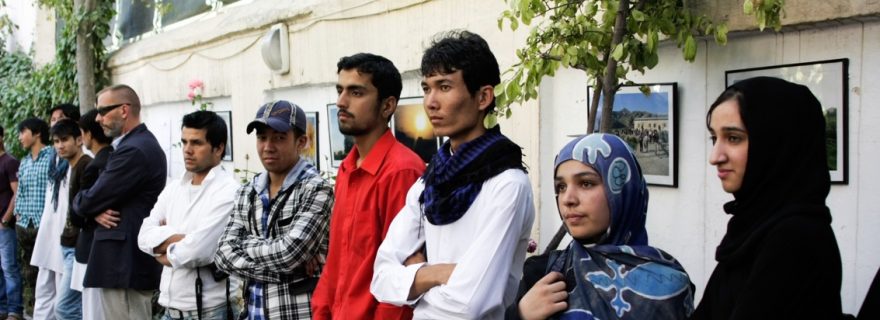Afghanistan’s Youth: Force of Progress or Future Firebrands?
While Afghanistan has one of the youngest populations, the country’s political scene is still dominated by the powerholders of old: former warlords, tribal strongmen, and religious leaders. Will the youth be a force of modernization or of future conflict?
Every election in Afghanistan you see the same candidates: former warlords and politicians that came to the fore after the toppling of the Taliban regime in 2001. Still mostly men of course. While they do not necessarily all represent conservative values, they have one thing in common: they belong to a previous generation from a past characterized by four decades of conflict. Afghanistan has one of the youngest populations in Asia, but these demographics have so far not translated into a new generation of younger politicians.
Not long after 9/11, German sociologist Gunnar Heinsohn came up with a possible explanation for the ongoing war and terrorism in Afghanistan. He pointed out that, while conflicts are mostly explained by ethnic and religious tensions, there is another factor that is often neglected: enormous population growth. In short, his argument is that conflicts continue because there is an endless amount of young men who make these conflicts possible. He writes in the 2008 (Dutch) version of his book Söhne und Weltmacht: “When you consider the enormous number of children and young people, it is not surprising that Afghanistan did not settle down after the rapid American victory on November 25, 2001. (…) It will be (…) a miracle if peace can be restored before 2025, when the population will almost have doubled. In that year, at least half of the 52 million inhabitants will be under the age of 20 (…).”
He uses the term “youth bulge,” a disproportionately large group of young people in the population. This is the case if at least 20 percent of the population consists of 15- to 24-year-olds or at least 30 percent of 0- to 15-year-olds. Estimates vary but more than 60 percent of Afghans are under 25. The situation is not unique in the region. Pakistan and India both have similar youth bulges, while in Iran it is getting smaller quite rapidly. In the view of Heinsohn, the youth bulge is a "demographic weapon" that does not explain all the violence in the world, but often plays a crucial role in conflicts.
It is striking that, in Heinsohn’s theory, factors such as religion, poverty, or the lack of food and education play little or no role: His theory mainly concerns the group of “well-fed” and “ambitious young people” who are looking for power or status: “(…) the crucial point is ultimately how many young men are frustrated in their ambitions.”
His theory paints a rather grim picture of Afghanistan’s future and seems to contradict the thesis that young people in Afghanistan can be a source of progress and modernity. Despite the fact that some frustrated young people have fled Afghanistan in recent years, the majority does not have that option. The question then is whether those who remain are susceptible to conservative tendencies or whether they can make a difference if they are given the opportunity to do so.
Ultimately, the societal context determines what the role of the Afghan youth can be. And in that context religion is still very important. The predominantly conservative Islamic society sets the boundaries and determines the pace of modernization. It determines how strong the roots of a cultural identity continue to be, which is what Thomas Friedman called the “olive tree” in his 1999 book The Lexus and the Olive Tree. This desire to maintain certain traditions, Friedman juxtaposed with the drive for progress and prosperity – in his terminology “the Lexus.”
Despite the strong call of the olive tree in Afghanistan, the opposing call for modernity does not stop. Globalization, “the Lexus” or what political scientist Benjamin Barber described in 1995 as “McWorld” will continue to attract Afghan youth. Interestingly, this is not necessarily based on the soft power of the West, as the cultures of other Asian countries, including Iran and India, also has a big influence on young Afghans.
So what does that mean for Afghanistan’s future? We have two opposing forces that are both very strong. It is a tug-of-war of cultural values and identities. Heinsohn’s analysis about conflict driven by millions of “angry young Afghans” seems too pessimistic and deterministic. When you look, however, at the unequal benefits of globalization, a downside also acknowledged by Friedman, Heinsohn’s core argument might be very relevant. The key question then becomes: What will these young Afghans do when they notice that they cannot drive a Lexus but at best a Toyota Corolla? When they realize that they have a university degree but no job opportunities to match it? When they cannot all benefit from a Fulbright scholarship?
For Barber, it was ultimately not about the choice between “McWorld” and what he called “jihad” (cultural fundamentalism), but mainly about how to create a strong civil society and democratic citizenship. This requires major upheavals, including a real political transition and a democratization process that truly focuses on Afghan youth. If they are provided access to the right political spaces, I have no doubt that the new generations can finally put a stop to more than four decades of conflict and suffering. The next big test? The intra-Afghan peace process.
Dr Jorrit Kamminga (@JorritKamminga) is Visiting Fellow at the Clingendael Institute and Policy Lead Inclusive Peace and Security at Oxfam Novib. This article is written in a personal capacity.



0 Comments